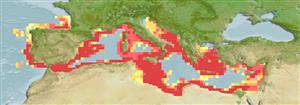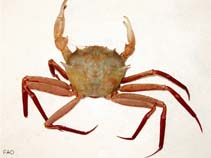Geryon longipes Milne-Edwards, 1882
Mediterranean geryon| Native range | All suitable habitat | Point map | Year 2050 |

|
| This map was computer-generated and has not yet been reviewed. |
| Geryon longipes AquaMaps Data sources: GBIF OBIS |
Classification / Names Common names | Synonyms | CoL | ITIS | WoRMS
Malacostraca | Decapoda | Geryonidae
Environment: milieu / climate zone / depth range / distribution range Ecology
Benthic; depth range 5 - 1950 m (Ref. 106297). Subtropical; 46°N - 30°N, 13°W - 36°E
Distribution Countries | FAO areas | Ecosystems | Occurrences | Introductions
Northeast Atlantic and the Mediterranean Sea.
Length at first maturity / Size / Weight / Age
Maturity: Lm ? range ? - ? cm Max length : 6.8 cm CL male/unsexed; (Ref. 114235); 2.7 cm CL (female)
Maximum depth from Ref. 122885. Maximum length for females from Ref. 106104. Both max. lengths are based on occurrences (Refs. 106104, 114235); to be replaced with a better reference. Deep-sea species that inhabits bathyal mud bottoms (Ref. 106307). Occurs on the deep middle (Ref. 105217) and lower slope where the species is abundant (Ref. 122885). Recorded in the deep sea along with the gorgonacean coral Isidella elongata (Ref. 122886).
Life cycle and mating behavior Maturity | Reproduction | Spawning | Eggs | Fecundity | Larvae
Members of the order Decapoda are mostly gonochoric. Mating behavior: Precopulatory courtship ritual is common (through olfactory and tactile cues); usually indirect sperm transfer.
Main reference
References | Coordinator | Collaborators
Bisby, F.A., M.A. Ruggiero, K.L. Wilson, M. Cachuela-Palacio, S.W. Kimani, Y.R. Roskov, A. Soulier-Perkins and J. van Hertum. 2005. (Ref. 19)
IUCN Red List Status (Ref. 130435)
CITES status (Ref. 108899)
Not Evaluated
CMS (Ref. 116361)
Not Evaluated
Threat to humans
Human uses
Fisheries: commercial
| FishSource |
Tools
More information
Internet sources
BHL | BOLD Systems | CISTI | DiscoverLife | FAO(Publication : search) | Fishipedia | GenBank (genome, nucleotide) | GloBI | Gomexsi | Google Books | Google Scholar | Google | PubMed | Tree of Life | Wikipedia (Go, Search) | Zoological Record
Estimates based on models
Preferred temperature
(Ref. 115969): 13.1 - 14.8, mean 13.9 (based on 204 cells).
Resilience
(Ref. 69278):
High, minimum population doubling time less than 15 months (K=0.3-0.54).



